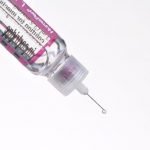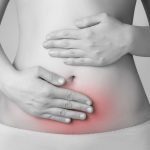Fertility and Toxicity: The Powerful Effects of Endocrine Disruptors
Alison Schulz, ND
Andrew Litchy, ND
Endocrine disrupting compounds (EDCs) are chemicals with the potential to alter the production, metabolism, and activity of hormones in humans and animals. These substances display a variety of idiosyncratic biochemical effects, with complex and multifactorial mechanisms of disruption of endocrine systems. EDCs may mimic or antagonize endogenous hormones, overstimulate various hormone-related receptors, alter hepatic hormone metabolism, and interfere with steroidogenesis. These substances have only recently come to our attention, and their toxicological effects are not well understood. However, the known toxic effects of EDC exposure extend well beyond the disruption of endocrine function. Many EDCs show multigenerational effects in animal models. Widespread contamination of EDCs in food and water supplies, low-dose biologic activity, and tendency toward bioaccumulation in the human body indicate that EDCs pose a serious and unknown health risk to the global community.
EDCs and Fertility
Infertility, defined as the inability to conceive after 1 year of unprotected intercourse, is increasing. Fertility rates in the United States have been declining since 1980, reaching the lowest rate in 2009, at 64.1 per 1000 women aged 15 to 44, according to the National Vital Statistic Report published in 2010.1 Genetic changes cannot explain this trend, especially considering this short time-frame of declining fertility. Exposure to synthetic chemicals is a possible explanation and fits the observed time frame.2 EDCs have been linked to many health issues. With regards to reproductive health, they have been associated with increased rates of endometriosis, polycystic ovaries, hypothyroidism, preterm birth, miscarriage, genital deformities, and decreased quality and quantity of sperm.3
Some reports on the toxicology of EDCs minimize concern about the potential toxic effects on humans. It is important to acknowledge that much of the research on these compounds has been performed or sponsored by companies in industry-related organizations, and by scientists affiliated with the production of the compounds studied.4,5,6 Unfortunately, there are reasons for concern. Animal studies are troubling, and early human studies are consistent with the large body of knowledge on the effects of EDCs on fertility and reproduction in animals.7 Unfortunately, current epidemiological data on the prevalence of human exposure, bioaccumulation, and health effects of these toxins may be inadequate due to limited testing and insufficient understanding of individual patterns of bioaccumulation and excretion of EDCs. Data is limited on effects of low-level exposures of any particular chemical in humans, and even less is known about the effects of exposure to multiple chemicals. Multigenerational effects found in animal models are not yet apparent in humans due to the recent introduction of these chemicals. Patterns of bioaccumulation vary by species, which complicates extrapolation to humans; however, these compounds can be detected at significant levels in a very large percentage of the human population.8
EDCs of Major Concern
There are hundreds of known endocrine-disrupting chemicals, most of which will not be addressed in this article. Table 1 lists a few of the most omnipresent and well-studied EDCs.
Table 1. Endocrine-Disrupting Chemicals & Fertility
| Endocrine Disruptor | Common Sources | Potential Effects on Fertility |
| Dioxins/ Dioxin-like Compounds (eg, PCBs) | Byproducts of many manufacturing processes Byproducts of some herbicides and pesticides Commonly found in meat, fish, and dairy products More than 90% of human exposure is thought to be through food |
Fetal and early-life exposure can permanently affect sperm quality and lower sperm count in men during reproductive years10 Reduction in testicular weight, lower levels of testosterone3,12 Shorter menstrual cycles in females; premature puberty and altered sex ratios in children11Dioxins can exert either estrogenic or anti-estrogenic effects, depending on amount and timing of exposure10 |
| Phthalates | Vinyl flooring, adhesives, detergents, lubricating oils, automotive plastics, and medical tubing Daily-use products, eg, shower curtains, tablecloths, children’s toys, raincoats, and plastic wrap made with the recycling #3 label Some personal care products, eg, insect repellents, hair spray, shampoo, nail polish, cosmetics, and fragrance13 |
The greatest concern of exposure is during reproduction and human development Anti-androgenic effects, eg, testicular dysgenesis syndrome including premature apoptosis in testicular cells, resulting in lower testosterone levels and sperm count13 Damage to sperm DNA, decreased sperm mobility14 Birth defects in the male reproductive system, eg, hypospadias, shorter anogenital distance, cryptorchidism2,13 Premature sexual development in females, especially early breast development15 Impaired folliculogenesis2 |
| BPA/Phenols | Used in plastics with recycle code #7 and epoxy resins Frequently used in the food industry for packaging and liners of canned foods Used in carbonless copy paper and thermal paper of receipts22 |
BPA closely mimics the structure and function of estradiol23 Higher BPA concentrations are associated with lower serum estradiol and lower oocyte yield and number of fertilized eggs24 Disrupted oocyte maturation, altered development of reproductive organs24-27 |
| Perfluorinated Chemicals (PFCs) | Non-stick cookware, stain repellants and coatings for fabrics and carpetingAbsorbed by ingestion, inhalation, and dermal contact16 | Lower sperm quality, low birth weight, and thyroid disease16-20Decreased fertility is associated with increased maternal and paternal serum PFC levels21 |
(PCBs = polychlorinated biphenyls; BPA = bisphenol A)
Dioxins & Dioxin-like Compounds (PCBs)
By the determination of the 2001 Stockholm Convention, dioxins have been labeled as 1 of 12 persistent organic pollutants (POPs). Persistent organic pollutants are organic compounds resistant to biodegradation, and have been observed to persist in the environment and bioaccumulate in the tissues of humans and other animals. Dioxins are semi-volatile, chlorinated, 2 or 3-ring molecules capable of long-range dissemination through the atmosphere and water supply.9 The half-life of these compounds in the body is estimated to be 7-11 years.10 Dioxins are commonly found in meat, fish (particularly farmed fish), and dairy products. More than 90% of human exposure is thought to be through food.10
Polychlorinated biphenyls (PCBs) are classified as dioxin-like compounds, and although they were banned in 1979, they are still present in the environment.11 These compounds are known to affect a number of organ systems, including the reproductive, immune, and neurological systems. Dioxins are closely linked to cancers of the breast, liver, and digestive tract.12 PCBs can mimic estrogen and are associated with lower sperm counts, altered sex organs, changes in testosterone and estrogen ratios, premature puberty, and altered sex ratios in children.11 PCBs tend to change in the body and in the environment from more highly-chlorinated to lower-chlorinated forms, which have greater estrogenic effects.11 Several studies have also investigated the estrogen-linked effects of PCBs, and concluded that PCBs can exert either estrogenic or anti-estrogenic effects, depending on the dose and timing of exposure. In animal studies, exposure to PCBs in utero and through breast milk has been shown to reduce testicular weight by 30%, with a 60% decline in serum testosterone levels.12
Phthalates
Phthalates are present in many household products. They are plasticizers, and are used as an additive to polyvinyl chloride (PVC) plastics to make them soft, flexible, and strong. Typically, the more flexible a plastic, the higher the amount of phthalates in the product.13
Phthalates are known to have an anti-androgenic activity. Studies have shown an increase in apoptosis of germ cells in fetal testes, which correlates with maternal levels of phthalate metabolites. There appears to be reduced anogenital distance and increased incidence of hypospadias in neonates whose mothers test positive for urinary phthalates, indicating in-utero anti-androgen effects.13 One study of workers in a factory that produced PVC flooring found that male workers had a significant reduction of serum free testosterone compared to the general population.14 Another study at an infertility clinic found an association in men between higher concentrations of phthalate metabolites and increased damage to sperm DNA, and skewed ratios of testosterone to estradiol (suggestive of aromatase suppression).14 In females, phthalates have been associated with premature sexual development.15
Perfluorinated Compounds
Perfluorinated compounds (PFCs) are ubiquitous agents in non-stick cookware. These compounds have unique hydro- and lipophilic properties that make them desirable compounds for a variety of purposes, including stain repellants and coatings for cookware, fabrics, and carpeting. These compounds are absorbed by oral intake, inhalation, and dermal contact. This family of compounds has variable toxicity, in-vivo biodegradation, and bioaccumulation. However, studies examining the most common bio-accumulating species demonstrate potentially carcinogenic activity and many deleterious health effects of PFCs, including decreases in fecundity with increased maternal and paternal serum PFC concentrations.16 Multiple studies demonstrate robust negative effects on human male reproductive function, including poor semen quality17-20 and decreased reproductive hormones.21
Bisphenol A
Bisphenol A (BPA) is found in many plastics and epoxy resins. It is absorbed orally, by inhalation, and by dermal contact. BPA is used frequently in food industry, and is found in plastics, liners of canned food, and other packaging.22 Thermal paper used to print receipts also contains high amounts of BPA, which is absorbable through contact.
BPA closely mimics the structure and biologic function of estradiol. BPA concentrations in human females have been associated with lower serum estradiol level, and reduced oocyte yield, mature oocyte count, and number of normally fertilized oocytes.23 BPA and phthalates are both associated with many reproductive side effects, including disrupted oocyte maturation, impaired steroidogenesis, and altered development of reproductive organs.24-27
According to the National Institute of Environmental Health Science, BPA has been found in the urine of over 95% of adults and 93% of children in several recent surveys, and multiple studies of children have revealed BPA intake levels above the EPA’s suggested safe limit of 50 µG/kg/day.28 Animal studies show toxic effects at much lower doses; for example, at 0.025 µG/kg/day, mouse models have demonstrated changes in the genital tract and breast tissue.29,30 Other concerning effects include changes in dopaminergic and reward systems, leading to increased impulsivity, hyperactivity, and increased susceptibility to addiction to drugs of abuse.31 The effects BPA exposure during gestation is transgenerational; in animal studies, effects on gene expression and behavior can persist through 4 generations.32
Testing & Treatment
Urine testing is available for measuring metabolites of BPA, parabens, phthalates, and organochlorides. Serum testing is available for various PCBs. These tests appear to be appropriate for monitoring treatment, as well as extrapolating changes in total body burden. When testing for EDCs, also consider markers of detoxification, oxidative stress, glutathione, and cofactors required to process environmental contaminants. If working with a couple for fertility, semen analysis should always be considered, as well as a basic workup of thyroid function, glucose metabolism, and hormone testing to rule out other underlying conditions such as polycystic ovarian syndrome (PCOS).
Detoxification of these bioaccumulating substances is complex, and there is a definite lack of an evidence base to inform treatment. However, there are still several promising strategies, and naturopathic physicians are trained in therapies that help to facilitate elimination and protect individuals during treatment.
Mobilizing Persistent Organic Pollutants
Adipose tissue appears to be a preferred and protective storage location for lipophilic toxins. Caloric restriction and decreasing adipose tissue have positive effects on the detoxification of POPs; for example, long-term weight loss has been associated with decreased concentrations of PCBs after 12-18 months.32 Weight loss and fasting must be carefully monitored, as these interventions can cause test subjects to be more vulnerable to toxic effects of these lipophilic xenobiotics in the short term. Furthermore, when these chemicals are mobilized but not excreted, they may be redistributed in the body to more vulnerable tissues.
Animal research suggests that high dietary intake of fat may lead to redistribution of POPs to the liver, brain, and kidney33; this is evidence of mobilization, but not elimination. Fish oil, rather than soy oil or lard, appears to specifically increase both excretion and mobilization of some POPs through a theorized upregulation of P450 enzymes.33 Purified fish oil is suggested rather than whole fish, since seafood can be a significant dietary source of POPs.
Facilitating Excretion
POPs appear to share pathways of absorption with dietary fat and fat-soluble nutrients. Detoxification of these compounds is complicated by the reabsorption of the chemicals before they can be excreted in stool or urine. Enterohepatic circulation is a potential locus for intervention when detoxifying lipophilic xenobiotics and POPs.34 Excretion of POPs may be enhanced by interfering with bile sequestration, fat absorption, and administering binding agents.
Bile Sequestration
Many POPs are reabsorbed with bile acids. Bile acid sequestrants such as cholestyramine appear to improve elimination of POPs in some cases.35 Calorie restriction or fasting in conjunction with cationic exchange resins like cholestyramine results in greater elimination of POPs compared to cholestyramine alone.36
Fat Absorption
Fat substitutes like olestra have been shown to improve elimination of POPs by interfering with lipid (re)absorption.37 Mineral and castor oil have been used in animal studies to reduce fat absorption; however, possible reabsorption of small amounts of mineral oil, and the profound irritation caused by oral castor oil, make these agents problematic.38
Epigallocatechin gallate (EGCG) and related polyphenols appear to aid elimination of POPs via several mechanisms.39 EGCG and other electrophiles such as sulforaphane stimulate known xenobiotic elimination pathways. ECGC increases cholesterol elimination via bile, which may be associated with increased elimination of lipophilic compounds. EGCG also appears to reduce the solubility of cholesterol in micelles and deactivate enteric receptors that facilitate bile reabsorption.39
Intestinal Binding Agents
Activated charcoal has not proven to be an effective detoxification agent for POPs; however, alginates, pectins, and guar gum appear to have utility in preventing reabsorption of POPs.40 Dietary fiber and indigestible polysaccharides also may increase elimination.
Aiding Elimination
Classical naturopathic philosophy and treatments are relevant to any EDC detoxification protocol. Stimulating the vital force and opening the primary emunctories (kidney, GI, skin, lung, and emotions) should be a primary concern to reduce side effects, improve quality of life, and reinforce healthful routines. Saunas and heat depuration are not an effective sole treatment for POP detoxification, but are a vital adjunct. Nutritional approaches to improving phase I and II detoxification, oxidative stress, and gastrointestinal health are relevant. Stress reduction and nature therapies are usually indicated with every patient, but are crucial when addressing infertility due to the stress of the condition, and effects of stress on hormonal health and reproductive health.
Conclusion
Endocrine-disrupting compounds are ubiquitous in the modern environment. They are potential causes of infertility and other hormonal defects, and present unique challenges to the clinician. Careful consideration of detoxification mechanisms, routes of exposure, and preventing bioaccumulation may yield positive outcomes in reducing body burden and reproductive outcomes.
 Alison Schulz, ND, is a graduate of National College of Natural Medicine (NCNM) and is in private practice in Portland, Oregon. She is an integrative family practitioner, but her primary interest is in women’s health care and fertility. Dr Schulz holds a degree in microbiology and worked in biotechnology before discovering her love for natural medicine. Her interests outside of practice include spending time with her family, cycling, and cooking for friends. She is also an avid DIY crafter with a passion for healthy skin care products. Website: www.Alisonschulznd.com
Alison Schulz, ND, is a graduate of National College of Natural Medicine (NCNM) and is in private practice in Portland, Oregon. She is an integrative family practitioner, but her primary interest is in women’s health care and fertility. Dr Schulz holds a degree in microbiology and worked in biotechnology before discovering her love for natural medicine. Her interests outside of practice include spending time with her family, cycling, and cooking for friends. She is also an avid DIY crafter with a passion for healthy skin care products. Website: www.Alisonschulznd.com
 Andrew Litchy, ND, is a graduate of the National College of Natural Medicine (NCNM) in Portland, Oregon. He is faculty at the University of Minnesota and NCNM. Andrew practices medicine utilizing biomedical research and time-tested naturopathic approaches at his clinic, The Bhakti Wellness Center in Edina MN. He is a founding member of the Integrated Team for Children with Challenges, and teaches loving-kindness meditation to several groups in the Twin Cities. When not in the clinic, Andrew can be found puttering around his garden or plunking away at the piano with his son. Websites: www.neighborhoodnaturopathic.com and www.bhakticlinic.com
Andrew Litchy, ND, is a graduate of the National College of Natural Medicine (NCNM) in Portland, Oregon. He is faculty at the University of Minnesota and NCNM. Andrew practices medicine utilizing biomedical research and time-tested naturopathic approaches at his clinic, The Bhakti Wellness Center in Edina MN. He is a founding member of the Integrated Team for Children with Challenges, and teaches loving-kindness meditation to several groups in the Twin Cities. When not in the clinic, Andrew can be found puttering around his garden or plunking away at the piano with his son. Websites: www.neighborhoodnaturopathic.com and www.bhakticlinic.com
References:
- Martin JA, Hamilton BE, Ventura SJ, et al. Births: Final Data for 2010. August 28, 2012. National Vital Statistics Reports. 2012;61(1). Available at: http://www.cdc.gov/nchs/data/nvsr/nvsr61/nvsr61_01.pdf. Accessed Nov. 10, 2014.
- Marques-Pinto A, Carvalho D. Human infertility: are endocrine disruptors to blame? Endocr Connect. 2013;2(3):R15-R29.
- Balabanic D, Rupnik M, Klemencic AK. Negative impact of endocrine-disrupting compounds on human reproductive health. Reprod Fertil Dev. 2011;23(3):403-416.
- Michaels D. Doubt is Their Product: How Industry’s Assault on Science Threatens Your Health. New York, NY: Oxford University Press; 2008.
- Angell M. The Truth About the Drug Companies: How They Deceive Us and What to Do About It. New York, NY: Random House; 2004.
- Topol EJ. Failing the public health – Rofecoxib, Merck, and the N Engl J Med. 2004;351(17):1707-1709.
- Genuis SJ. The chemical erosion of human health: adverse environmental exposure and in-utero pollution – determinants of congenital disorders and chronic disease. J Perinat Med. 2006;34(3):185-195.
- Chang SC, Das K, Ehresman DJ, et al. Comparative pharmacokinetics of perfluorobutyrate in rats, mice, monkeys, and humans and relevance to human exposure via drinking water. Toxicol Sci. 2008;104(1):40-53.
- Ritter L, Solomon KR, Forget J, et al. Persistent organic pollutants. United Nations Environment Programme. Available at: http://www.chem.unep.ch/pops/ritter/en/ritteren.pdf. Accessed September 16, 2007.
- World Health Organization. Dioxins and their effects on human health. Updated June 2014. WHO Web site. http://www.who.int/mediacentre/factsheets/fs225/en/. Accessed November 10, 2014.
- Johnson BL. What are the human health effects of PCBs? Clearwater News & Bulletins. Available at: http://www.clearwater.org/news/pcbhealth.html#refs. Accessed November 13, 2014.
- International Programme on Chemical Safety (IPCS). Polychlorinated Biphenyls: Human Health Aspects. Concise International Chemical Assessment Document 55; 2003. Geneva, World Health Organization, IPCS. Available at: http://www.inchem.org/documents/cicads/cicads/cicad55.htm. Accessed November 13, 2014.
- Crinnion WJ. Toxic effects of the easily avoidable phthalates and parabens. Altern Med Rev. 2010;15(3):190-196.
- Huang LP, Lee CC, Hsu PC, Shih TS. The association between semen quality in workers and the concentration of di(2-ethylhexyl) phthalate in polyvinyl chloride pellet plant air. Fertil Steril. 2011;96(1):90-94.
- Chou YY, Huang PC, Lee CC, et al. Phthalate exposure in girls during early puberty. J Pediatr Endocrinol Metab.2009;22(1):69-77.
- Vestergaard S, Nielsen F, Andersson AM, et al. Association between perfluorinated compounds and time to pregnancy in a prospective cohort of Danish couples attempting to conceive. Hum Reprod. 2012;27(3):873-880.
- Raymer JH, Michael LC, Studabaker WB, et al. Concentrations of perfluorooctane sulfonate (PFOS) and perfluorooctanoate (PFOA) and their associations with human semen quality measurements. Reprod Toxicol. 2012;33(4):419-427.
- Vested A, Ramlau-Hansen CH, Olsen SF, et al. Associations of in utero exposure to perfluorinated alkyl acids with human semen quality and reproductive hormones in adult men. Environ Health Perspect. 2013;121(4):453-458.
- Buck Louis GM, Chen Z, Schisterman EF, et al. Perfluorochemicals and Human Semen Quality: The LIFE Study. Environ Health Perspect. 2014 Aug 15. [Epub ahead of print]
- Toft G, Jonsson BA, Lindh CH, et al. Exposure to perfluorinated compounds and human semen quality in Arctic and European populations. Hum Reprod. 2012;27(8):2532-2540.
- Lau C, Anitole K, Hodes C, et al. Perfluoroalkyl acids: a review of monitoring and toxicological findings. Toxicol Sci. 2007;99(2):366-394.
- Lakind JS, Naiman DQ. Daily intake of bisphenol A and potential sources of exposure: 2005-2006 National Health and Nutrition Examination Survey. J Expo Sci Environ Epidemiol. 2011;21(3):272-279.
- Ehrlich S, Williams PL, Missmer SA, et al. Urinary bisphenol A concentrations and early reproductive health outcomes among women undergoing IVF. Hum Reprod. 2012;27(12):3583-3592.
- Hunt PA, Koehler KE, Susiarjo M, et al. Bisphenol A exposure causes meiotic aneuploidy in the female mouse. Curr Biol 2003;13:546-553.
- Kim EJ, Kim JW, Lee SK. Inhibition of oocyte development in Japanese medaka (Oryzias latipes) exposed to di-2-ethylhexyl phthalate. Environ Int. 2002;28(5):359-365.
- Akingbemi BT, Sottas CM, Koulova AI, et al. Inhibition of testicular steroidogenesis by the xenoestrogen bisphenol A is associated with reduced pituitary luteinizing hormone secretion and decreased steroidogenic enzymegene expression in rat Leydig cells. 2004;145(2):592-603.
- Kato H, Ota T, Furuhashi T, et al. Changes in reproductive organs of female rats treated with bisphenol A during the neonatal period. Reprod 2003;17(3):283-288.
- Vandenberg LN, Chauhoud I, Heindel JJ, et al. Urinary, circulating and tissue monitoring studies indicate widespread exposure to bisphenol A. Environ Health Perspect. 2010;118(8):1055-1070.
- Markey CM, Wadia PR, Rubin BS, et al. Long-term effects of fetal exposure to low doses of xenoestrogen bisphenol-A in the female mouse genital tract. Biol Reprod. 2005;72(6):1344-1351.
- Muñoz-de-Toro M, Markey CM, Wadia PR, et al. Perinatal exposure to bisphenol-A alters peripubertal mammary gland development in mice. Endocrinology. 2005;146(9):4138-4147.
- Suzuki T, Mizuo K, Nakazawa H, et al. Prenatal and neonatal exposure to bisphenol-A enhances the central dopamine D1 receptor-mediated action in mice: enhancement of the methamphetamine-induced abuse state. Neuroscience. 2003;117(3):639-644.
- Walford RL, Mock D, MacCallum T, Laseter JL. Physiological changes in humans subjected to severe selective calorie restriction for two years in biosphere 2: health, aging, and toxicological perspectives. Toxixol Sci. 1999;52(2 Suppl):61-65.
- Umegaki K, Ikegami S. Feeding fish oil to rats accelerates the metabolism of hexachlorobenzene. J Nutr Sci Vitaminol (Tokyo). 1998;44(2):301-311.
- Jandacek RJ, Tso P. Enterohepatic circulation of organochlorine compounds: a site for nutritional intervention. J Nutr Biochem. 2007;18(3):163-167.
- Sakurai K, Fukata H, Todaka E, et al. Colestimide reduces blood polychlorinated biphenyl (PCB) levels. Intern Med. 2006;45(5):327-328.
- Johnson JD, Gibson SJ, Ober RE. Cholestyramine-enhanced fecal elimination of carbon-14 in rats after administration of ammonium [14C]perfluorooctanoate or potassium [14C]perflurorooctanesulfonate. Fundam Appl Toxicol. 1984;4(6):972-976.
- Redgrave TG, Wallace P, Jandacek RJ, Tso P. Treatment with a dietary fat substitute decreased Arochlor 1254 contamination in an obese diabetic male. J Nutr Biochem. 2005;16(6):383-384.
- Moser GA, McLachlan MS. A non-absorbable dietary fat substitute enhances elimination of persistent lipophilic contaminants in humans. 1999;39(9):1513-1521.
- Xu C, Li CY, Kong AN. Induction of phase I, II and III drug metabolism/transport by xenobiotics. Arch Pharm Res. 2005;28(3):249-168.
- Jandacek RJ, Tso P. Factors affecting the storage and excretion of toxic lipophilic xenobiotics. Lipids. 2001;36(12):1289-1305.









